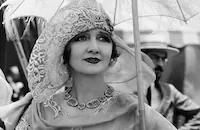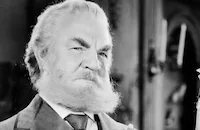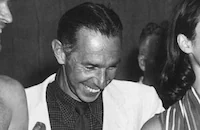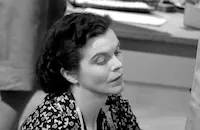Cross-Country Romance

Brief Synopsis
Cast & Crew
Frank Woodruff
Gene Raymond
Wendy Barrie
Hedda Hopper
Billy Gilbert
George P. Huntley
Film Details
Technical Specs

Synopsis
Larry Smith is a young bacteriologist on his way from New York to San Francisco to work under an eminent scientist in China. He stops along the way at the North house to deliver a scroll appointing socialite Mrs. North an honorary trustee of the hospital in recognition of her charity work. His visit interrupts the wedding of Mrs. North's spoiled daughter Diane to the stuffy Walter Corbett, and Diane, seizing the opportunity to dodge her nuptials, stows away in Larry's trailer, wearing nothing but her slip. On the road, Larry discovers that he has acquired a passenger and refuses to believe Diane's story that she is the daughter of the prominent North family. To placate him, Diane concocts a phony name and story and decides to win his heart while he determines to rid himself of her as soon as possible. As they venture across the country, however, the two fall in love and are married. Meanwhile, Mrs. North's offer of a reward for the return of her missing daughter triggers a nationwide search, and when Larry learns that he has married publicity hungry heiress Diane North, he throws her out and boards an airplane to fly to his boat in San Francisco. Diane follows him aboard, and the couple are reconciled as they voyage to China.

Director
Frank Woodruff
Cast

Gene Raymond

Wendy Barrie

Hedda Hopper

Billy Gilbert
George P. Huntley

Berton Churchill
Tom Dugan
Edgar Dearing
Frank Sully
Cliff Clark
Dorothea Kent
Tommy Mack

Jack Arnold
Maurice Cass
Esther Dale
George Watts
Lionel Pape
Yolande Mallott
Nanette Vallon
Landers Stevens
Edward Dew
Herbert Vigran
Mike Lally
Ronnie Rondell
Charles Coleman
James Carlyle
Joey Ray
Louis Mason
Earle S. Dewey

Dorothy Adams
Joe Bernard

Alan Ladd
Herbert Rawlinson
Kernan Cripps
Carl Freemanson
Ralph Sanford
Crew
Jerry Cady
Albert D'agostino
Bailey Fesler
Bert Granet
J. Roy Hunt
Gaston Longet
Lee Marcus
Harry Marker
Helen Meinardi
Edward Melcher
Jo Milward
William Jefferson Parker
Van Nest Polglase
Cliff Reid
Renie
Vernon L. Walker
Roy Webb

Videos
Movie Clip


Hosted Intro
Film Details
Technical Specs

Articles
Cross Country Romance
RKO joined the craze with Cross-Country Romance. Officially, the story was adapted from the novel Highway to Romance by Eleanor Browne. But the tidy 68-minute film deviated little from the It Happened One Night model and features a heiress who takes flight from her own wedding in the trailer of an unsuspecting doctor. This time around, the girl on the run is played by Wendy Barrie and Gene Raymond stars as her traveling companion and eventual love interest. Cross-Country Romance also boasts a bit part by a future superstar - Alan Ladd appears as First Mate Williams.
Ladd had made his screen debut eight years earlier in the William Wyler directed drama Tom Brown of Culver (1932). This small, uncredited role would be the first in a string of bit parts for Ladd. Over the next ten years he would appear in blink-and-you'll-miss-him roles in everything from the Ritz Brothers musical The Goldwyn Follies (1938) to Citizen Kane (1941). Ladd was still a fledgling actor when he appeared in Cross-Country Romance; that same year (1940) he would pay his dues in seventeen films, including the Ronald Reagan comedy Brother Rat and a Baby, the Joseph Conrad adventure Victory and the Cary Grant Revolutionary War film The Howards of Virginia. Ladd's efforts would finally pay off two years later with his breakthrough role in This Gun for Hire (1942). For his turn as the psychopath Raven, Ladd received fourth billing and became an overnight success in the role.
The real stars of Cross-Country Romance, however, were Wendy Barrie and Gene Raymond. Barrie, who had launched her career on the English stage, first came to the attention of international audiences in Alexander Korda's The Private Life of Henry VIII (1933). Soon, Hollywood came calling, casting Barrie in high profile films such as the critically acclaimed Dead End (1937); the aviation disaster flick Five Came Back (1939); and the Sherlock Holmes mystery The Hound of the Baskervilles (1939). Barrie had also starred opposite George Sanders in two Saint films -- The Saint Strikes Back (1939) and The Saint Takes Over (1940) -- by the time she made Cross-Country Romance and had been teamed previously with Gene Raymond in Love on a Bet (1936).
Raymond came off a two-year acting hiatus to make Cross-Country Romance. His career had been doing quite well. Raymond found himself in a love triangle with Clark Gable and Mary Astor in Red Dust (1932); got involved with Joan Crawford in Sadie McKee (1934); and was paired with Dolores Del Rio in Flying Down to Rio (1933), the first film to showcase the talents of Fred Astaire and Ginger Rogers. But now, it was Raymond's personal life that made headlines. Just three years earlier, in 1937, he had crushed the romantic notions of movie fans everywhere when he wed Jeanette MacDonald half of America's Singing Sweethearts (who many fans believed should marry on screen love Nelson Eddy). The following year, Raymond and MacDonald would co-star in their only picture together, Smilin' Through (1941).
Along with Ladd, Raymond and Barrie are bolstered by a top-notch supporting cast in Cross-Country Romance. None other than gossip maven Hedda Hopper appears as Barrie's mother; she would make just three more films before airing Hollywood's dirty laundry as a profession. Character actor Billy Gilbert also stands out in the role of Orestes and is best remembered for providing comedic support to the likes of Laurel and Hardy in Block-Heads (1938) and Charlie Chaplin in The Great Dictator (1940).
Producer: Cliff Reid
Director: Frank Woodruff
Screenplay: Jerome Cady, Bert Granet, based on the novel "Highway to Romance" by Eleanor Brown
Cinematography: J. Roy Hunt
Art Direction: Van Nest Polglase
Film Editing: Harry Marker
Cast: Gene Raymond (Dr. Lawrence Smith), Wendy Barrie (Diane North), Hedda Hopper (Mrs. North), Billy Gilbert (Orestes), G.P. Huntley (Walter Corbett), Berton Churchill (Col. Conway), Alan Ladd (Mr. Williams).
BW-69m.
by Stephanie Thames

Cross Country Romance
Quotes
Trivia
Notes
This picture marked Gene Raymond's return to the screen after a two-year absence.















